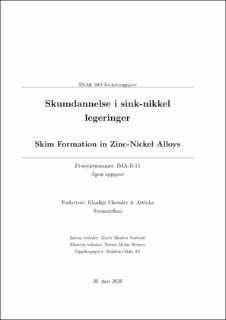| dc.contributor.advisor | Sørtveit, Marte Mørkve | |
| dc.contributor.advisor | Werner, Tobias Mohn | |
| dc.contributor.author | Sivananthan, Arthika | |
| dc.contributor.author | Choudry, Khadija | |
| dc.date.accessioned | 2020-07-22T16:01:22Z | |
| dc.date.available | 2020-07-22T16:01:22Z | |
| dc.date.issued | 2020 | |
| dc.identifier.uri | https://hdl.handle.net/11250/2669920 | |
| dc.description.abstract | Denne oppgaven ble skrevet i samarbeid med Boliden Odda AS. Ved produksjon av sink-nikkel legeringer dannes det uønsket skum. Dette skummet er problematisk da det er lite salgbart og skaper problemer for røreverket og pumpen i ovnen. I tillegg er det tungt og hardt arbeid for operatørene som fjerner dette manuelt. Hovedhensikten med denne oppgaven var å analysere det uønskede skummet.
Analysen av skummet ble gjennomført ved hjelp av elektronmikroskop (SEM) og lysmikroskop (OM). Dette ble gjort for å karakterisere sammensetningen og mikrostrukturen til skummet. Det ble hentet ut totalt ti prøver fra ovnen utover to dager, i forbindelse med et besøk hos Boliden Odda AS. Alle prøvene ble undersøkt i OM, men kun Prøve A, B og 4 ble undersøkt i SEM.
I analysen kom det frem at det er uløste nikkelpartikler tilstede i skummet. Ved hjelp av EDS-analyse og fasediagram ble dette tydet til å være α-fasen da denne fasen besto av 95,8 at% Ni og 4,2 at% Zn. Partiklene befant seg adskilt av en ny fase i en oksidmatriks. Det tydet på at den nye fasen besto av γ-fasen og to-fasen, γ+δ. Det ble antatt at denne fasen ikke var et oksid som medførte at verdiene for Zn og Ni ble normalisert. Dette resulterte i at denne fasen besto av 84 - 88 at% Zn og 12 - 16 at% Ni, og tydet på å være sink-nikkel legering. Oksidmatriksen var satt sammen av mindre mengder nikkel, 12 - 15 at% oksygen og omtrent samme mengde sink, og tydet på å være skum.
Nikkel er et dyrt materiale. Da skummet inneholder nikkelpartikler kan det være interessant å se på gjenløsning av skummet for å hindre materialtap. En mulighet kan være å undersøke hvordan sammensetningen og mikrostrukturen til skummet påvirkes etter en varmebehandling. | |
| dc.description.abstract | This thesis was written in collaboration with Boliden Odda AS. During the production of Zinc-Nickel alloys, unwanted skim is formed. The market value of the skim is low and it causes problems for the stirrer and the pump in the furnace, which is problematic. It is heavy and hard work for the operators that removes the skim manually. The main purpose with this thesis was to analyze the skim.
The analysis of the skim was done by using a scanning electron microscope (SEM) and an optical microscope (OM). This was done to characterize the composition and microstructure of the skim. Ten samples were taken from the furnace in connection with a visit to Boliden Odda AS. All the samples were examined in OM, but only Sample A, B and 4 were examined in SEM.
The analysis revealed that unsolved nickel particles are present in the skim. By EDS analysis and phase diagram this was assumed to be the α-phase as this phase consisted of 95,8 at% Ni and 4,2 at% Zn. The particles were separated by a new phase in an oxide matrix. The new phase was assumed to be the γ-phase and the binary phase γ+δ. It was assumed that this phase was not an oxide which led to normalization of the values for Zn and Ni. This phase was consisted by 84 - 88 at% Zn and 12 - 16 at% Ni, and was assumed to be a Zn-Ni alloy. The oxide matrix was composed of smaller amounts of Nickel, 12 - 15 at% Oxygen and about the same amount of Zinc, and was believed to be the skim.
Nickel is an expensive material. Since the skim contains nickel particles, it may be helpful to look at dissolving the skim to prevent the material loss. One possibility could be to investigate how the composition and microstructure of the skim is affected after a heat treatment. | |
| dc.publisher | NTNU | |
| dc.title | Skumdannelse i sink-nikkel legeringer | |
| dc.type | Bachelor thesis | |
